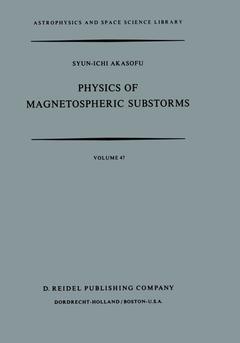Description
Physics of Magnetospheric Substorms, Softcover reprint of the original 1st ed. 1977
Coll. Astrophysics and Space Science Library, Vol. 47
Coordinator: Akasofu Syun-Ichi
Language: French
Subject for Physics of Magnetospheric Substorms:
Keywords
Publication date: 01-2012
617 p. · 17x24.4 cm · Paperback
617 p. · 17x24.4 cm · Paperback
Description
/li>Contents
/li>
Man, through intensive observations of natural phenomena, has learned about some of the basic principles which govern nature. The aurora is one of the most fascinating of these natural phenomena, and by studying it, man has just begun to comprehend auroral phenomena in terms of basic cosmic electrodynamic processes. The systematic and extensive observation of the aurora during and after the great international enterprise, the International Geophysical Year (lGY), led to the concept of the auroral substorm. Like many other geophysical phenomena, auroral displays have a dual time (universal- and local-time) dependence when seen by a ground-based observer. Thus, it was a difficult task for single observers, rotating with the Earth once a day, to grasp a transient feature of a large-scale auroral display. Such a complexity is inevitable in studying many geophysical features, in particular the polar upper atmospheric phenomena. However, it was found that their complexity began to unfold when the concept of the auroral substorm was introduced. In a book entitled Polar and Magnetospheric Substorms, the predeces sor to this book, I tried to describe the auroral phenomena as completely as possible in terms of the concept of the auroral substorm. At that time, the first satellite observations of particles and magnetic fields during substorms were just becoming available, and it was suggested that the auroral sub storm is a manifestation of a magnetospheric phenomenon called the magnetospheric substorm.
1 Open Magnetosphere and the Auroral Oval.- 1.1. Open Magnetosphere.- 1.2. Auroral Oval.- 1.3. Open Magnetosphere and the Auroral Oval.- 1.4. Solar Wind — Magnetosphere Dynamo.- References.- 2 Auroras and Auroral Particles.- 2.1. Introduction.- 2.2. Auroras in Different Local Time Sectors.- 2.3. Auroral Electrons: The Statistical Precipitation Pattern.- 2.4. Auroral Electrons: Spectra of Auroral Electrons.- 2.5. Auroral Electrons and Field-Aligned Currents.- 2.6. Auroral Particles and Atmospheric Emissions.- 2.7. Auroral Protons.- 2.8. Auroral Helium Ions (He++, He+) and Oxygen Ions (O+).- 2.9. Auroral Oval and the Polar Ionosphere.- 2.10. Summary.- References.- 3 Distribution of Plasmas in the Magnetosphere.- 3.1. Five Plasma Domains.- 3.2. Plasma Mantle.- 3.3. Polar Cusp.- 3.4. Plasma Sheet.- 3.5. Origin and Dynamics of the Sheet Plasma.- 3.6. Van Allen Belts.- 3.7. Plasmasphere.- 3.8. Magnetospheric Plasmas and Auroral Particles.- 3.9. Acceleration Processes of Arc-Producing Auroral Electrons.- References.- 4 Responses of the Magnetosphere to Interplanetary Disturbances.- 4.1. Interplanetary Disturbances.- 4.2. Interplanetary Pressure Disturbances and Magnetospheric Responses.- 4.3. Changes of the IMF EW Component and Magnetospheric Responses.- 4.4. Changes of the IMF NS Component and Magnetospheric Responses.- References.- 5 Magnetospheric Substorms: Introduction.- 5.1. A New Classification of Magnetospheric Disturbances.- 5.2. Substorm Energy ?? and Substorm Function ? = ?(?D).- 5.3. Substorm Intensity.- 5.4. Time-Dependent Merging.- 5.5. Magnetospheric Substorms.- 5.6. Geomagnetic and Magnetospheric Storms.- References.- 6 Magnetotail Phenomena During Magnetospheric Substorms.- 6.1. Introduction.- 6.2. B Vector Dipping.- 6.3. Plasma Sheet Thinning.- 6.4.Magnetotail Field BT and Radius RT.- 6.5. Auroral Bulge.- 6.6. Plasma Sheet Expansion.- 6.7. Plasma Flow.- 6.8. Other Important Magnetotail Phenomena.- References.- 7 Magnetospheric Currents During Substorms.- 7.1. Introduction.- 7.2. Field-Aligned Currents.- 7.3. Field-Aligned Currents and the Auroral Electrojets.- 7.4. Auroral Electrojets.- 7.5. Cross-Section of the Electrojets.- 7.6. Latitudinal Cross-Section of the Auroral Electrojet and its Relation to the Interplanetary Magnetic Field Polarity.- 7.7. Ionospheric Currents and Electric Fields.- 7.8. Thermospheric and Ionospheric Disturbances.- References.- 8 Penetrating Convection Electric Field, Plasma Injection and Plasmasphere Disturbances.- 8.1. Introduction.- 8.2. Penetration of the Convection Electric Field into the Inner Magnetosphere and the Resulting Plasma Injection.- 8.3. Relationship between Particles at the Geosynchronous Distance and Auroral Activity near the Geomagnetically Conjugate Point.- 8.4. ‘The Fault Line’.- 8.5. Drift Motions.- 8.6. Deformation of the Plasmasphere and Associated Ionospheric Disturbances.- References.- 9 Solar-Terrestrial Relations and Magnetospheric Substorms.- 9.1. Interplanetary Disturbances.- 9.2. Morphological Model of Magnetospheric Substorms.- 9.3. Concluding Remarks.- References.- Index of Names.- Index of Subjects.
© 2024 LAVOISIER S.A.S.
These books may interest you

Dayside and Polar Cap Aurora 105.49 €



